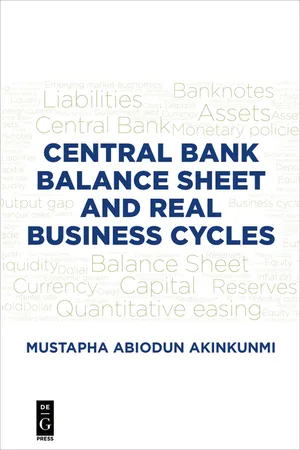
Central Bank Balance Sheet and Real Business Cycles
Mustapha Akinkunmi
- 200 pages
- English
- ePUB (adapté aux mobiles)
- Disponible sur iOS et Android
Central Bank Balance Sheet and Real Business Cycles
Mustapha Akinkunmi
À propos de ce livre
Central Bank Balance Sheet and Real Business Cycles argues that a deeper comprehension of changes to the central bank balance sheet can lead to more effective policymaking. Any transaction engaged in by the central bank—issuing currency, conducting foreign exchange operations, investing its own funds, intervening to provide emergency liquidity assistance and carrying out monetary policy operations—influences its balance sheet. Despite this, many central banks throughout the world have largely ignored balance sheet movements, and have instead focused on implementing interest rates.
In this book, Mustapha Abiodun Akinkunmi highlights the challenges and controversies faced by central banks in the past and present when implementing policies, and analyzes the links between these policies, the central bank balance sheet, and the consequences to economies as a whole. He argues that the composition and evolution of the central bank balance sheet provides a valuable basis for understanding the needs of an economy, and is an important tool in developing strategies that would most effectively achieve policy goals. This book is an important resource for anyone interested in monetary policy or whose work is affected by the actions of the policies of central banks.
Foire aux questions
Informations
Chapter 1
Global Genesis of the Central Bank
1.1Origin of the Central Bank
1.2Roles of the Central Bank
Questions
- What is the history of the central bank?
- What led to the establishment of the Federal Reserve?
- What are the roles of the central bank?
- What is the concept of the “central bank balance sheet”?
Chapter 2
Relevance of the Central Bank Balance Sheet
2.1Understanding Relevance of Central Bank Balance Sheet in Functions of Economy
2.1.1Similarities and Differences between a Company’s Balance Sheet and a Central Bank Balance Sheet
- A central bank’s balance sheet is prepared in line with the established guideline whereas a company’s balance sheet is prepared in relation to the regulation of the International Accounting Standards Board (IASB).
- The main objective of the central bank balance sheet is to ensure a stable financial system, while a company’s key objective is to present the accurate financial position of an organization to the stakeholders.
- The scope of a central bank’s balance sheet covers the financial system of the whole economy whereas the counterpart’s scope is applicable for all sorts of companies.
- A central bank’s assets and liabilities are very different from any regular company.
- The economic situation influences the composition of the central bank’s balance sheet; however, this is insignificant in a company’s balance sheet.

2.2Trajectory Relevance of the Central Bank Balance Sheet
Table des matières
- Cover
- Title Page
- Copyright
- Dedication
- Contents
- Chapter 1: Global Genesis of the Central Bank
- Chapter 2: Relevance of the Central Bank Balance Sheet
- Chapter 3: Components of Central Bank Balance Sheets
- Chapter 4: Analytical Framework of Central Bank Balance Sheets
- Chapter 5: Evolution of Central Bank Balance Sheets and Their Heterogeneous Dimensions
- Chapter 6: Composition of Central Bank Balance Sheet Assets
- Chapter 7: Financial Ratios of the Central Bank Balance Sheet
- Chapter 8: Central Bank Operations
- Chapter 9: Real Business Cycles
- Chapter 10: Central Bank Balance Sheets and Real Business Cycles
- Chapter 11: Conclusion
- Appendix I: Central Bank Balance Sheets of Different Countries
- Appendix II: Abbreviations
- References
- Index